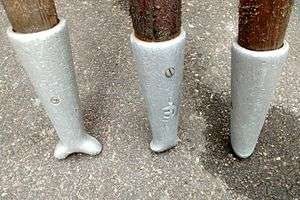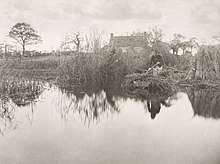Quant pole
A quant (quant pole) is a pole used to propel a barge (barge pole) or punt through water. A barge quant often has a cap at the top and a prong at the bottom to stop it from sinking into the mud. On the Norfolk Broads these are called a Bott and a Shoe respectively. A quant used with a punt is about 4 metres (13 ft) long and made from either wood or a hollow metal, so that in either case it floats if left in the water.

On the Norfolk Broads a quant is used to propel yachts, especially those lacking an engine, when the wind does not suit. Large sailing wherries employed a quant pole at least 8 metres (26 ft) in length.
A quant is used not only to propel such craft, but also to steer them by acting as a rudder. The operator of the quant can stick the quant behind the barge or punt to determine the direction of travel.
There is also a popular saying: "I wouldn't touch that thing with a barge pole!" (sometimes rendered as "a 10-foot pole").
Using a quant (quanting)

Propulsion
The quanter stands at the front of the barge or, for a punt, normally on the rear deck. The angle at which the quant is held depends on the depth of the water and the desired speed of travel. A steeper angle is required for deeper water (the bottom of the quant must be able to reach the bed of the river or canal) and a shallower angle required for speed. The quanter drives the quant downward and slightly backward to push the craft forwards. On a larger boat, the quanter then walks down the side of the boat, facing aft and braced against the quant pole, the boat being propelled forward at the speed he walks. To reverse, the quant can be pushed forwards. The quant is then pulled out of the water by placing hand over hand on it and pulling upwards (as if one were climbing down a pole).
When punting, as in Oxford and Cambridge, the quanter stands stationary at the back (Oxford and Cambridge disagree on which is the rear end: decked in Cambridge and undecked in Oxford) and slides the quant into the water at an angle forwards. As the punt glides forwards the loosely held quant becomes increasingly vertical. When the quant is just past the vertical, i.e. sloping downwards from front to back of the punt, the quanter pushes on the quant to propel the punt forwards. At the end of the pushing stroke the quant is twisted with a downward roll of the wrists to break it free from the bottom, and then retrieved by being thrown forwards hand-over-hand in readiness for the next stroke. A rhythmic and smooth style is usually considered to be 'good form'.
Disaster may strike if the quanter loses grip on the quant while attempting to extract it from the bottom, and the quant is left 'stuck in the mud' at an increasing distance behind the punt. This is not 'good form'. It is not unknown, when the quant sticks in the mud, for an inexperienced quanter to choose to hold onto the quant rather than letting go, with the result that the quanter is left dangling from the end of the quant, and subsides slowly into the water. This, too, is considered not 'good form'.
Steering
By dragging the quant at an angle behind the barge or punt upon the water, the craft can be made to turn. The craft will slow on the side on which the quant is in the water, so the craft will move in that direction. The greater the angle made between the quant and the barge or punt, the greater the turning angle. This effect can be enhanced (greater turning force), by pushing the quant forward through the water on the desired direction side of the craft.
Alternatively, propelling the boat with the quant placed such that there is an angle between the direction of motion and the line of the quant itself will push the rear of the craft away from the planted end of the quant, and so enable changes of direction. This method allows for corrections and steering to be accomplished without significantly slowing the craft, although it generally requires a greater degree of skill.